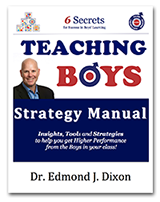The Process of Challenge -Taking
That word process is important for you, too. George Mallory did not take up the challenge of Mount Everest until he had challenged himself on smaller mountains. A boy’s journey on this pathway is also a process marked by small “wins” at first. The approach that I find works best in helping a boy to use challenge to learn is to start with those wins that are easily within his reach at home or school. And what happens at home should not be minimized. Helping boys successfully meet learning challenges outside of school improves their ability to accomplish learning in class. In particular, small “wins” in learning challenges are easy to create and build upon.
 As you turn to the suggested strategies to start you and your students down this path, you no doubt sense that this secret, like those of Mastery and Meaning, are not as simple an clear-cut as the strategies of movement, game and humor, but their rewards are much, much greater. Imagine what it would be like to find out in the future, that you helped a boy in taking up learning challenges independently and with passion, confident that whatever school or life throws at him, he has the resources to deal with it. That is what every teacher wants for his or her students…And this challenge approach is a great way to put your boy learners on that pathway…
As you turn to the suggested strategies to start you and your students down this path, you no doubt sense that this secret, like those of Mastery and Meaning, are not as simple an clear-cut as the strategies of movement, game and humor, but their rewards are much, much greater. Imagine what it would be like to find out in the future, that you helped a boy in taking up learning challenges independently and with passion, confident that whatever school or life throws at him, he has the resources to deal with it. That is what every teacher wants for his or her students…And this challenge approach is a great way to put your boy learners on that pathway…
TO TRY THIS WEEK…
Have the challenge contain elements of movement, game, and humor – As a teacher you don’t have to figure these out. Just include them in the success criteria for the task as a challenge within the assignment. Then let the kids discuss and experiment ways to meet the criteria, considering the following:
- How would you illustrate what you have discovered to someone who does not speak English?
- What would be a funny way that a TV or web commercial could get people to learn the facts you have discovered so they would buy something based on their knowledge? What would that something be?
- When presenting your data, your group will get extra credit if they can connect their presentation to another group’s presentation. The class will vote on the strength and creativity of those connections, and your group will receive credit as follows:
- 5% – Strong and creative connection
- 3% – Typical or obvious connection
- 1% – Weak connection
Build on one accomplishment with challenges for another – When you see a boy or group of boys meet a classroom challenge, make sure you recognize their success and ask them to think of ways that the challenge could be improved for the next class of students. Give them their “downtime” as discussed above, but also ask them to think about how a challenge might be built into the next topic (which you can post online or write on the board). The boys will likely be coming up with new ways to meet the next challenge in no time at all. Some may even prefer not to take the downtime and tackle the next task. If this happens, you are in a great place with the class, as it is evidence that you have tapped into the boys’ need for mastery that we will explore in the next chapter.




